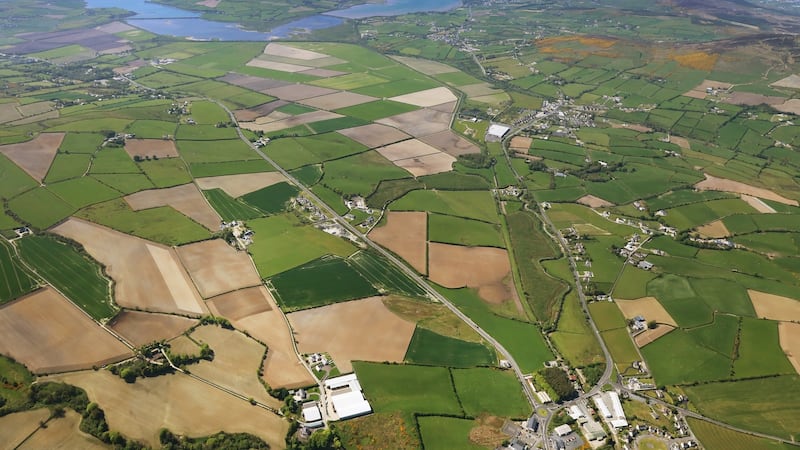An investigation has begun into a large-scale clearance of mature trees and hedgerows at one of the biggest organic farms in Europe, in Co Donegal, after a Government official alleged a breach of environmental protection laws.
Works at the 2,400-acre Grianán Estate farm in Inishowen, which includes a nature reserve and popular tourist trail, were on a “significantly larger scale” than permitted, Department of Agriculture files state.
The huge organic farm was bought for €17 million in 2017 by agriculture and renewable energy firm Glenmore Estate.
On lands mostly reclaimed from Lough Swilly, and including its own 500-acre lake, the farm supplies a number of well-known brands.
But it is also regarded as one of Donegal’s most important ecological habitats.
A large section is designated under the Lough Swilly Special Area of Conservation and Special Protection Area. These are prime wildlife areas protected by EU legislation as they are deemed to be of European as well as Irish importance.
Both Minister for Agriculture Michael Creed and Minister for Heritage Josepha Madigan have been questioned in the Dáil about “widespread concerns” over works at the farm.
Department of Agriculture records, released under Freedom of Information, show an official travelled there on April 20th last year after it was alerted to a “number of issues”.
‘Unauthorised activity’
In a letter dated June 26th, a department official told his colleague in the specialised farm division that he found “unauthorised activity” on the protected land during the unannounced visit.
“The scale of the work exceeds the thresholds stated in the EIA (Environmental Impact Assessment) regulations, 2011, and was on a significantly larger scale than the work detailed in the submission of September 2017,” he wrote.
An application was made to the Department in September 2017 for works on the farm.

The National Parks and Wildlife Service (NPWS), which is responsible for protecting Ireland’s nature reserves and leases a section of Grianán known as Inch Wildfowl Reserve under a 30-year agreement since 2001, was asked for its opinion.
The NPWS had no objections on the basis of the proposed works outlined in the application and providing the farm owner remains “fully compliant” with all regulations and statutory requirements.
An environmental impact statement was requested.
The department official said there was no record of any environmental impact statement having been prepared “and in my opinion, there has been a breach of the relevant legislation on the site concerned”.
Offence with fines
The Environmental Impact Assessment Regulations 2011 require an assessment be carried out before any works commence, and a breach of the legislation constitutes an offence with fines of up to €250,000 on conviction.
The official added: “Based on the evidence on the ground, I believe that the activities carried out on the site have been carried out without the requisite consent and there is no evidence to indicate that the NPWS were aware of the developments on the site.”
Sinn Féin Senator Pádraig Mac Lochlainn, who lives nearby, said there was “widespread concern in the communities around this farm at the scale of what has happened and the impact on sensitive wildlife and the environment”.
Karol McElhinney, a farmer and businessman who heads Glenmore Estate, said he did not know how many trees or hedgerows were removed as “it was a contractor who did it” but that everything was carried out with the required approval.
“Anything we removed we got approval for, that needed approval,” he said.
Mr McElhinney said any felling of trees and hedging was for “maintenance and health and safety” reasons.
The Department of Agriculture said it was “currently investigating” a complaint about the “possible contravention of the EIA ( Agriculture Regulations) 2011.”
The Department of Heritage, which oversees the NPWS, said concerns about the works were raised with it on three occasions.
“On occasions where works were identified as requiring a licence or consent from a public authority the works were stopped by local NPWS staff,” said a spokeswoman.
“On all such occasions, the land owner was informed of the consent required or the works reported to the relevant authority.”
The spokeswoman added: “The department does and will continue to investigate any breaches of relevant legislation including the Wildlife Acts and the European Communities (Birds and Natural Habitats) Regulations 2011.”
‘Some of these trees were maybe 80 years old’
Malcolm Riddell knows every nook and cranny of the expansive lowlands reclaimed from Lough Swilly over a century and half, now known as Grianán Estate.
Since setting up home at Burt, under the ancient Grianán hill fort, in 1974 he has watched over the once tidal mudflats, transformed by decades of engineering into Ireland’s largest arable farm.
Swans, geese – Canada geese, greylags and even occasionally pink-footed geese – mingle with the small hedgerow birds that make the distinctive, stretching landscape one of Donegal’s most ecologically prized.
That was, Mr Riddell says, until last year.
“I noticed the new owners started clearing drains shortly after the new year - which I thought was a good thing, and I didn’t mind the hedgerows being trimmed back,” says the 73-year-old, who retired from Derry’s Housing Executive seven years ago.
“But what really started to alarm, not only myself, but a lot of people who enjoy the wildlife here is when they started cutting down the trees as well – trees in the hedgerows rapidly disappeared along with the hedges.
“Some of these trees were maybe 80 years old.”
Owners Glenmore Estates, the Department of Agriculture, which issues consents for such works, and the National Parks and Wildlife Service, which leases a large section of the farm as a nature reserve, cannot or will not say how much was removed.
However, Karol McElhinney, who heads Glenmore Estate, said everything was carried out with the required approval.
“Anything we removed we got approval for, that needed approval,” he said.
Mr Riddell believes hundreds of trees and miles of hedgerow have been torn out.
Ashes, sycamores, birches, whitebeams and willows – known locally as “sallies”and which thrive in wetlands – are among the casualties.
“The sallies were a big loss. They have loose bark on them, which cracks, giving insects places to live, and where small birds can then feed,” he says.
“The place looked an absolute disaster, mounds of muck and soil, broken trees, pulled out trees. Hedges that had been cut lying everywhere. It looked as if the area would never be back to what it was.”
For the first time in 44 years last spring, swans and geese that grazed the flatlands had moved elsewhere, says Mr Riddell. Neighbours say buzzards and otters have also been displaced.
There has been some improvement since, he says.
“The hedges will grow again, but it will take many a year – 15 or 20 years – before there is anything substantial there again.”











